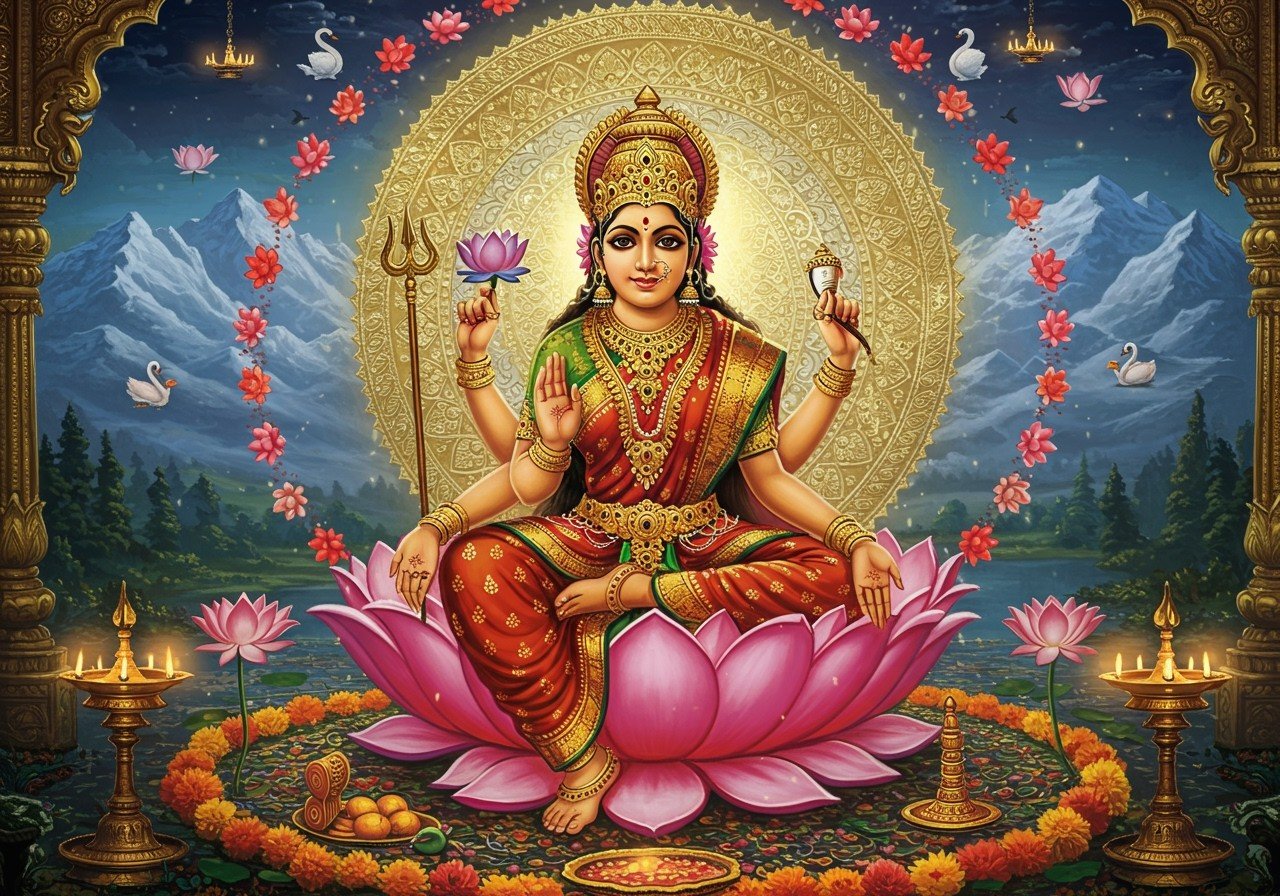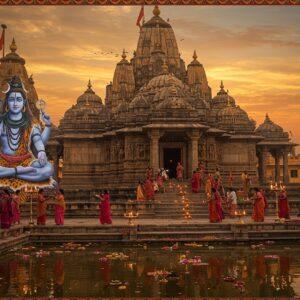
Parvati’s iconography is a vital aspect of Hindu art and religious symbolism. Known as the goddess of fertility, love, and devotion, she plays a crucial role in Hindu mythology as Shiva’s consort. Her depiction in art is deeply entrenched in Indian tradition, reflecting cultural and religious significance. This article explains the colors, symbols, and attributes associated with Parvati for those seeking authentic representations.
Parvati’s Preferred Colors
Color holds immense significance in Parvati’s iconography. Green, a color often associated with Parvati, symbolizes fertility, life, and renewal, aligning with her role as a goddess of nature and growth. Green also represents prosperity and abundance. Red, another significant color often seen in her attire, symbolizes power, passion, and devotion, reflecting her marital status and her dynamic energy. Red also speaks to her role as a protector and warrior goddess. These colors, when used in Parvati’s depictions, effectively communicate different facets of her personality and divine attributes. Understanding these color choices provides a deeper appreciation of her role as both a nurturing and a powerful goddess.
Symbols and Attributes of Parvati
Parvati’s iconography offers a glimpse into her divine nature. The symbols and attributes she holds convey her spiritual power and grace. The lotus flower, often depicted in her hand, represents purity, beauty, and spiritual enlightenment. Its delicate nature yet resilient growth mirrors the spiritual journey itself. The lotus rising from murky waters signifies the rise of the spirit above worldly attachments. Parvati’s connection to Shiva is evident through the trident she sometimes carries. It symbolizes their union, her shared power, and her role as a protector of the cosmos. The trident’s three prongs represent the three fundamental qualities of creation, preservation, and destruction, highlighting her involvement in the cosmic cycle. The conch shell, another attribute associated with Parvati, heralds her divine presence and the auspiciousness she brings. Its sound is believed to dispel negativity and purify the surroundings. The conch’s spiral shape echoes the cyclical nature of time and the universe. In rituals, the conch’s sacred sound invokes positive energy and invites divine blessings. Each of these symbols reflects Parvati’s multifaceted nature, illustrating her influence on various aspects of life—love, protection, and spiritual growth.
Parvati’s Depiction and Appearance
In Hindu art, Parvati is typically depicted with grace and serenity. Her appearance radiates warmth and divine beauty. Her serene expression conveys peace, compassion, and wisdom. She is often shown with two or four arms, demonstrating her divine abilities and omnipresence. More arms allow her to hold multiple symbols, signifying her diverse powers and roles. Parvati’s attire often includes a richly adorned red sari. This vibrant color signifies her status as a married goddess and embodies power and devotion. Red also symbolizes her active energy and her ability to transform. Her jewelry, often elaborate and gleaming, denotes her divine status, beauty, and the abundance she bestows. A crown typically adorns her head, symbolizing her regal nature, authority, and her role as a goddess of high esteem. Her serene demeanor and compassionate gaze encourage devotion among worshippers.
Parvati’s Role in Hindu Mythology
Parvati’s role in Hindu mythology is profound and inspiring. As Shiva’s devoted consort, their relationship showcases balance, unity, and the interplay of seemingly opposing forces. Their union symbolizes the harmony between renunciation and worldly engagement, demonstrating the importance of both spiritual detachment and active participation in life. Parvati’s tales emphasize devotion, strength, and perseverance. Her unwavering penance to win Shiva’s heart serves as a testament to her dedication and the power of love. This story resonates deeply with themes cherished by many: love, sacrifice, and the strength found in unwavering commitment. As Durga, a fierce warrior goddess, Parvati exhibits protective traits and her capacity for righteous anger. This powerful incarnation highlights her nurturing spirit while also showcasing her formidable strength when confronting evil. Durga’s battles symbolize the triumph of good over evil and the protective power of the divine feminine.
Parvati’s Influence on Cultural Practices
Parvati’s symbolism deeply influences Hindu cultural practices. Festivals like Navratri, a nine-night celebration, honor her in various forms, recognizing her divine feminine energy and her diverse manifestations. During Navratri, devotees worship different aspects of the goddess, seeking her blessings for strength, prosperity, and wisdom. Her imagery appears in rituals, temple art, and home shrines, reflecting her central role in ceremonies and daily devotion. These traditions promote values of family, devotion, and spiritual growth—values that remain central to Indian life. Parvati’s influence inspires and guides devotees on their spiritual journeys. Her presence in art and ritual strengthens connections to traditional values, providing a tangible link to the divine feminine and the rich heritage of Hindu spirituality.
How Poojn.in Can Enhance Your Devotion to Parvati
Poojn.in offers a wide selection of items for your Parvati puja. Here are some products that align with traditional iconography and worship:
- Red Sarees and Cloths: Find authentic red vastras for dressing the deity, honoring her traditional color symbolism. These beautiful fabrics add an element of reverence and respect to your worship. Explore our collection of red sarees and cloths on Poojn.in.
- Pure Copper Items: Browse our selection of copper puja items, such as kalash and diyas, which represent purity in worship. Copper is considered a sacred metal and enhances the positive energy of your rituals. Discover our copper puja items on Poojn.in.
- Sindoor and Kumkum: Find high-quality vermillion powder, a key symbol of Parvati’s married status and feminine energy. Sindoor and kumkum are essential for many Parvati pujas and rituals. Find authentic sindoor and kumkum on Poojn.in.
All items on Poojn.in come with authenticity certificates and are carefully sourced. We deliver across India with secure packaging.
Conclusion
Parvati’s iconography is rich with meaning and tradition, offering a profound connection to her divine essence. Her symbols and attributes, from the delicate lotus to the powerful trident, reveal her purity, strength, and protective nature. Through these elements, Parvati inspires spiritual growth and balance, embodying love, devotion, and the power of the feminine divine. Her appearance, adorned in vibrant attire and jewels, reflects her divine grace, authority, and the abundance she bestows. In mythology, Parvati’s stories of dedication and power resonate with themes of love and perseverance, imparting valuable lessons about commitment and inner strength. Culturally, Parvati’s influence is evident in festivals and rituals, strengthening spiritual and familial bonds. Her enduring legacy continues to guide and inspire devotees, bridging the sacred with everyday life. Through Parvati, traditions are honored, spiritual journeys are embraced, and lives are enriched.
Frequently Asked Questions about Parvati
What are some common epithets for Parvati? Parvati is known by many names, including Uma, Gauri, Ambika, and Shakti, each reflecting a different aspect of her divine personality.
These names highlight her diverse roles and powers, from her gentle and benevolent aspects to her fierce and protective manifestations.
How is Parvati connected to nature? Parvati is often associated with mountains, forests, and the natural world. Her name itself, “Parvati,” means “she of the mountain,” referring to her being the daughter of Himavan, the king of the mountains. This connection to nature emphasizes her role as a life-giver and nurturer.
She embodies the fertile energy of the earth and the protective embrace of the mountains.
Learn about Rudraksha and Tulsi


